Others
How to Dominate the TikTok Search Engine
Article written by Vismaya Babu
Lead SEO Specialist at SurveySparrow
12 min read
19 September 2025

If your brand is on TikTok and you’re not taking advantage of its search engine yet, you’re missing out on lots of opportunities.
Let’s give you a bit of context. According to Google’s own internal data, almost half of GenZ are using TikTok and Instagram for search over Google!
Essentially, beyond the fun videos and viral challenges, TikTok users are also turning to its search feature when they need information and inspiration. So, the next question is: how can you make sure your content dominates the TikTok search engine for relevant queries?
Today’s guide will cover the most effective ways to take over the TikTok search engine. You’ll also discover how Tiktok scraping can help streamline your efforts.
But first things first:
TikTok Searching Trends
TikTok searching is catching on, and the younger generations are leading the charge.
Around 40% of young people use TikTok as their primary search engine. Prabhakar Raghavan, Senior Vice President at Google, revealed this at a Brainstorm Tech Conference in 2022.
Adobe also recently conducted a survey confirming the younger demographic as the most significant users of TikTok search. Out of the people who confirmed using TikTok, 64% were Gen Zs, and 49% were millennials. Only 29% and 14% were Gen X and baby boomers, respectively.

So, if most of your potential consumers are millennials and Gen Zs, optimizing your presence to rank on TikTok becomes a no-brainer.
Considering the traction TikTok search is gaining, businesses are also actively turning to TikTok search ads to maximize their brand discovery on the platform. Here’s how these ads show up on the platform:

Clinique UK happens to be one of the early adopters of this feature. The brand saw a 441% increase in conversion rates and 51% click-through rates on its content through TikTok search ads.
Why is TikTok Search Gaining So Much Traction?
The most obvious reason is the result format–video content.
44% of people prefer watching videos to learn, whether it’s about a product or service. This leaves other materials in the dust, like ebooks (16%) and text-based articles (13%). So, it makes perfect sense why some internet users would prefer to get their information through TikToks.
Video format aside, the platform provides more direct and relatable answers to user queries.
Take a Google search for “Restaurants in Vancouver,” for example. What you’ll get are local 3-pack or Google Map results and probably outdated reviews from Eater or TripAdvisor.
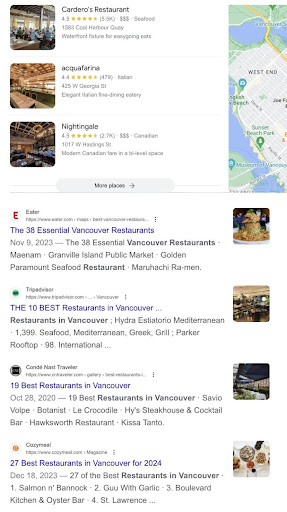
But things are different on TikTok. The searcher is either getting a better view of the restaurant’s aesthetics or restaurant recommendations based on the experience of real people who have tried them.

With this level of detail, it’s very natural for customers to prefer TikTok content over traditional search results. And mind you, searchers can always comment, ask questions, and get answers in real-time from the results. This enhances the user experience even further.
How To Leverage TikTok Search
Now, you know why TikTok search is becoming more popular and appealing. But how can you take advantage of this social platform?
It’s fairly straightforward. You just have to understand how to optimize your presence and content strategy in a way that appeals to TikTok search engine algorithms.
The social media platform algorithms rank search results based on several factors, but most importantly:
- Account settings of the users: The results users see for certain queries depend on their country, language, device, and other predefined preferences.
- Video information: The TikTok algorithm looks at the video’s hashtags, captions, and music to show the most relevant content for the queries.
- The value of the video: the platform measures how much a user likes a video by how long they watch it. So, if they watch a video till the end, it signals to the algorithm that such a video is valuable. That means the video is more likely to be displayed in the search results when someone searches for a query related to the video.
You’d typically have very little to no control over the account settings of your intended audience. So, to take advantage of the TikTok search engine, focus on optimizing the information and value of your video.
But before you do that, you need to do some research. You have to find out what keywords or hashtags your target audience is mostly searching for. Then, incorporate them in your descriptions.
You also need a good idea of the kind of content that satisfies the search intent of the keywords. For example, is it a DIY tutorial? You can find out by checking the content already ranking for the keywords or search query.
The best way to research your keywords and analyze your competitors at a scale on TikTok is via TikTok scraping. That brings us to the next topic;
What is TikTok Scraping
TikTok Scraping is the process of extracting data from TikTok, using tools or scripts, such as scrapers, bots, or web crawlers. This process helps you gather valuable information from the app, including top-performing videos, hashtags, or even sounds for certain user queries or competitor profiles.
How to Scrape Data from TikTok
Here are some steps you must follow to perform TikTok scraping effectively:
1. Establish the Goal for Scraping
Of course, you don’t just want to collect data blindly. Knowing your goal helps you determine the data you need. This way, you’d only collect relevant information and avoid unnecessary information.
For example, your goal, in this case, would be to appear high on the TikTok search engine for niche-relevant content. That means collecting information like emails would be a waste of effort since you’re not launching an email marketing campaign. So, the smart move would be to focus on data related to competitor strategies, trending topics, and user engagement.
2. Select a Scraping Technique
The right scraping approach for you will depend on your level of expertise. You can create a custom scraping script from scratch if you’re familiar with Python or have in-house experts. Moreover, for simpler tasks, curl to python tools can be a great option. These tools translate curl commands into Python code, making it easier to leverage existing knowledge and automate data extraction without extensive programming. If this is not the case, you should settle for a beginner-friendly automated TikTok scraper like Apify.
Apify lets you collect TikTok data based on inputs like search queries and hashtags. Therefore, you’ll first need to create a list of search keywords and hashtags your target audience uses.
To find the search queries, you can type a phrase related to your niche in TikTok’s search box. Before hitting the search button, you’ll find suggestions for long-tail keywords people use. The same works for hashtags. Now, all you need to do is identify the keywords relevant to you.
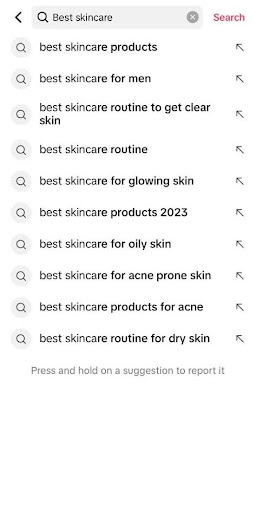
You’ll also find a list of other related keywords within the search results. You can note these, too.
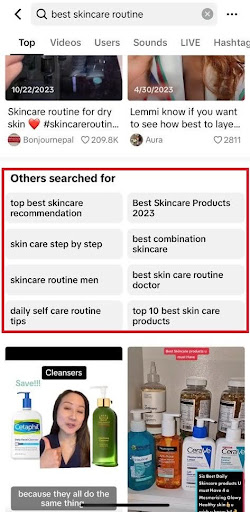
Another way to find hashtags people are searching for is by using TikTok hashtag insights. This tool allows you to select the industry to which your business belongs. Then, it curates a list of popular hashtags relevant to it. See an example for the food and beverage industry below:
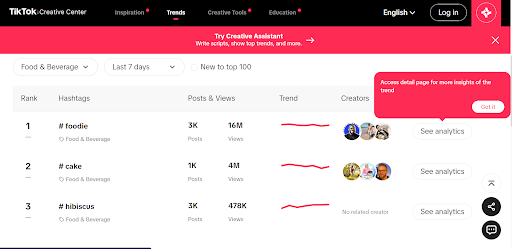
Once you have the keywords and hashtags, feed them into the Apify TikTok scraper:
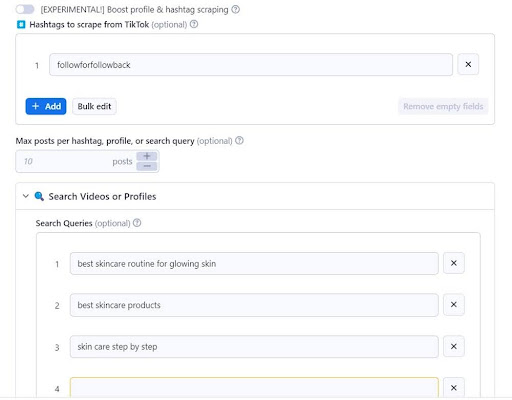
Within minutes, the tool will return data showing the competitor profiles, top-performing posts, music, hashtags used, and other insights.
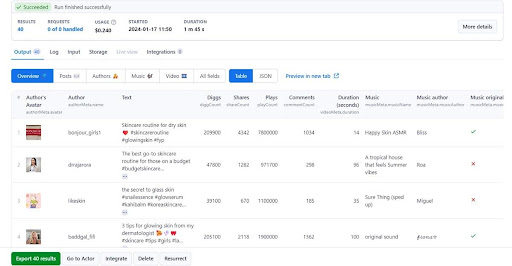
3. Analyze the Scraped Data
The raw data you’ve collected up to this point is just a collection of numbers and texts. To get any meaningful or actionable knowledge, you need to analyze it.
A good TikTok scraper allows you to access the data on a simple table, as shown above. This way, you can gain clear insights into everything about the top-ranking videos, such as the duration, captions, hashtags, and kinds of music used.
But if you’d prefer more advanced analysis, you can export the data set in JSON, CSV, Excel, or other formats. That should give you more leeway to analyze and visualize the data further.
Best Practices of Ethical TikTok Scraping
While TikTok scraping can be a useful practice, it can also be risky and unethical if you don’t do it the right way.
For instance, it could violate the user’s privacy or even breach certain data protection regulations. We don’t want that. So follow these best practices for ethical TikTok scraping:
1. Review Platform’s Terms of Service
Before anything, you want to familiarize yourself with TikTok’s terms of service to know what’s allowed and what’s prohibited.
For instance, according to TikTok’s terms of service, the platform frowns against using the data made available for unlawful activities like promoting spyware. Doing that could get you into legal trouble.
2. Pay Attention to ‘robots.txt’ File
A robots.txt file tells scrapers what content they can and cannot access on a website. It’s vital to respect the instructions and limitations present in this file. Avoid scraping any data that TikTok restricts. See TikTok’s robots.txt file below:
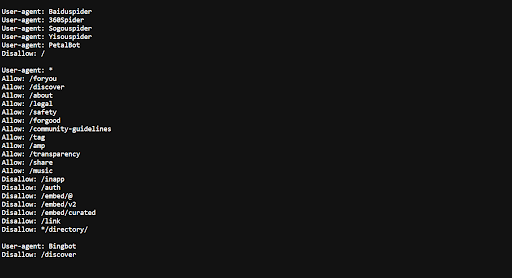
3. Monitor Scraping Activity
You always want to keep an eye on your scraping activity so it doesn’t go beyond reasonable limits. That’s because exceeding the limits might interfere with the normal functioning of the platform you’re scraping from. And before it does, TikTok will most likely block you from accessing its platform, which you don’t want.
The ideal thing to do is to limit the frequency and the volume of your scraping requests. You also want to ensure a reasonable delay between each request, say two to five seconds. That should help you avoid sending too many requests within a short period.
you must comply with the data protection regulations applicable to your industry and location. Popular examples include;
- General Data Protection Regulation (GDPR) in the European Union
- California Consumer Privacy Act (CCPA) in the United States
- Personal Data Protection Act (PDPA) in Singapore
The rules regarding data usage across these regulations can differ greatly. But mostly, they emphasize the importance of respecting the rights and privacy of the users whose data you scrape.
How To Dominate TikTok Search with Scraping
TikTok scraping plays a critical role in helping you dominate the TikTok search engine results. It effectively handles the process of researching and uncovering important information to inform your content marketing strategy. Scraping TikTok helps you identify:
- Keywords used in descriptions
- Hashtags used
- Video durations
- Sounds used
By incorporating these insights into your videos, you’ll stand a better chance of appearing higher in the TikTok search engine results.

Thousands of brands trust SurveySparrow to turn feedback into growth. Try it free today!
Vismaya Babu
Marketing professional with 10+ years of experience working on content-led growth, website performance, and inbound visibility for B2B SaaS products. Has contributed to scaling inbound pipelines and improving conversion paths across high-traffic product and educational pages.
Related Articles

Others
Top 10 Competitor Analysis Tools for Different Use Cases
16 MINUTES
23 May 2024
![Choice-Based Conjoint Analysis: Building Better Market Research [Step-by-Step Guide] Choice-Based Conjoint Analysis: Building Better Market Research [Step-by-Step Guide]](/_next/image/?url=https%3A%2F%2Fstatic.surveysparrow.com%2Fsite%2Fstrapi-content%2Fuploads%2F2025%2F09%2Fsmall_61_a44369f3e2.png&w=3840&q=75)
Others
Choice-Based Conjoint Analysis: Building Better Market Research [Step-by-Step Guide]
12 MINUTES
24 September 2025

Others
October Leaves, Halloween Trick ‘o Treats!
3 MINUTES
5 October 2018

Others
4 Reasons That Things Fail - An Interview with Gordon Tredgold
12 MINUTES
24 March 2020
